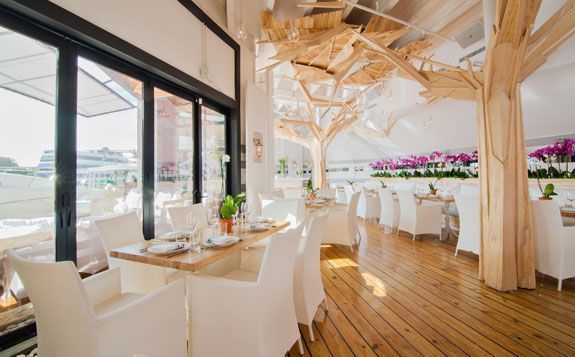Miami is ringing in a slew of recently opened restaurants with the new year. Here’s a look at the latest and greatest.
Midtown Oyster Bar {3301 Northeast First Avenue, Suite 103-1, Miami; 786.220.2070}
From the creators of Salumeria 104 comes Midtown Oyster Bar, a seafood-centered restaurant located inside the Shops at Midtown. You’ll find a daily selection of oysters plus many other New England favorites that have a hint of Italian, like Scampi Crudi, Lobster Rolls, and other seasonally-inspired items. The restaurant is cozy yet elegant, with nautical accents and colors, comfortable seating, a dimly lit bar, raw offerings at the oyster bar, and an inviting outdoor patio.
Tamarina {600 Brickell Avenue, Miami; 305.579.1888}
Tamarina is a new concept by famed restaurateur Arjun Waney—who co- founded zuma, Coya, La Petite Maison, and The Arts Club in London—and husband-and-wife team Yona and Tunu Puri. Enjoy authentic, seasonal Italian coastal cuisine in the restaurant’s pristine dining room, and don’t miss the chance to order from the oyster bar, the restaurant’s crown jewel. Also of note is Tamarina’s alfresco, candlelit terrace with its own Champagne bar.

Siena Tavern {404 Washington Avenue, Miami Beach; 305.534.5577}
What began as a trip to his native Italy has now transpired into a tantalizing culinary venture by Fabio Viviani, a “Top Chef” Season Five fan favorite. Opened in November in Miami’s quiet SoFi neighborhood, Siena Tavern has found the perfect balance between an upscale eatery and an upbeat tavern, with a lush dining room and outdoor terrace, open kitchen, and a fully-stocked bar with a cocktail menu curated by bartenders Elad Zavi and Gabriel Orta of the acclaimed Broken Shaker in South Beach. The menu includes locally-sourced produce and seafood, as well as Siena Tavern’s signature dishes, like Wagyu Beef Meatball and housemade Gnocchi with Truffle Cream and Crispy Pancetta. It’s as if Siena met South Beach, and it doesn’t get much better than that.
American Social {690 Southwest First Court, Miami; 786.801.2466}
Whether you arrive by foot or by sea, American Social is the place to be when you’re looking for a good time with friends. Just ask anyone in Fort Lauderdale, where the original haunt has a cult following. It was the first restaurant in South Florida to implement a table tap system, which puts pouring power in the hands of its customers. With a hefty selection of 52 craft beers and counting, it’s definitely a place for beer connoisseurs. Whether you come to watch a game on one of their 20 high-definition TVs, or simply for the live music and DJs on any given night, you’re guaranteed a good time.
IKRA Restaurant & Lounge {16850 Collins Avenue #106, Sunny Isles Beach; 305.974.0081}
As the largest restaurant in Sunny Isles, IKRA offers six distinct dining areas in which to indulge in extravagant seafood dishes, all prepared under the direction of Patrick Kirchner, who has worked at five-star restaurants across the globe. But besides the food and the live nightly entertainment, IKRA is notable for one thing that no other restaurant in Miami can offer: babysitters on staff, who will watch the little ones in a separate play room. Parents, you’ve found your nirvana.
Lokum Mediterranean Bar and Grill {1629 Alton Road, Miami Beach; 786.768.2423}
Located at the corner of Alton and Lincoln Road; Lokum Mediterranean Bar and Grill serves authentic Mediterranean cuisine at one of South Beach’s most bustling intersections. With options to dine in, take out, or place an order for delivery, Lokum offers affordable and quick cuisine for under $15, whether you’re into healthy appetizers like Baba Ghanoush and freshly-made tzatziki, or you just want a classic Falafel.
Moye {829 Southwest First Avenue, Miami; 305.372.5168}
Moye, Brickell’s latest Italian import, embraces the spirit of its parent restaurant—the much revered Sardinia Enoteca in Sunset Harbour—adding its own touch to classic regional Italian cuisine. With three locations in Milan and Florence, the restaurant is inspired by the cuisine of Puglia, known as the birthplace of Burrata, and for its great wines and olive oils. Fresh mozzarella and breads are made in-house daily in Moye’s open kitchen, and the restaurant features a rotating seasonal menu guests can enjoy inside the restaurant’s intimate 70-seat dining room or in its airy patio.
Campania {4029 North Miami Avenue}
In addition to newcomer Moye, the team behind Sardinia Enoteca is bringing more regional Italian cuisine onto mainland Miami. Campania, located in the former Egg & Dart space in the Design District, focuses on the sun-kissed cuisine of Napoli and the Amalfi Coast. Expect made-to-order pizzas created in its custom- made pizza oven, along with a retail marketplace where you can purchase fresh mozzarella and other authentic Italian products.
Cibo {100 South Pointe Drive at Continuum, South Beach; 305.442.4925}
After seeing much success with a location on Miracle Mile in Coral Gables, Cibo Wine Bar will be opening this December in the up-and-coming South of Fifth area in South Beach. The brand is most notable for its extensive wine selection, impeccable service, and rustic Italian cuisine. This South Beach location is a special one, as it offers the only rooftop venue in the entire neighborhood.
Babylon Turkish Restaurant {560 Washington Avenue, Miami Beach; 786.216.7230}
Babylon brings traditional, fine-dining Turkish cuisine to vibrant South Beach. Experience relaxed, comfortable elegance, along with sultry belly dancers and world music entertainment, every night. Whether indoors under an elaborate mosaic chandelier or upon the restaurant’s lush, tree-lined patio, a meal here makes you feel as though you’ve actually stepped into the storied Gardens of Babylon. Order from a menu of classic Turkish mezes, lamb plates, seafood dishes, kabobs, moussaka, and more. Finish with a scratch-made dessert. Come to Babylon, and savor the deliciously revived flavors of an ancient empire.
Cleo {17756 Collins Avenue, Miami Beach; 305.534.2536}
Listed as number five on OpenTable’s list of “50 Hottest Restaurants in the U.S.,” Cleo is poised to impress guests in Miami just as it did in Los Angeles and Las Vegas. The Mediterranean-inspired menu is enhanced to reflect South Beach’s bold, tropical flavors. Located within The Redbury South Beach, Cleo’s old-school Tinseltown setting spells dress up to dine. Continue feeling fancy as you sip specialty cocktails made with fresh juices and tropical ingredients. You can’t get much “hotter” than that.

STRIPSTEAK at the Fontainebleau Miami Beach {4441 Collins Avenue, Miami; 877.326.7412}
It has arrived. What, you ask? The award-wining, hot-trotting, Las Vegas-based concept from acclaimed Chef Michael Mina: STRIPSTEAK. This past November, STRIPSTEAK debuted at the Fontainebleau Miami Beach—as if we didn’t already have a reason or five to stroll into the hotel for a meal before this development. Yes, there’s our beloved Hakkasan, La Côte, and MICHAEL MINA 74, but now there’s also what promises to be a fantastic new concept calling our name. Here are a few reasons why we’re particularly excited: à la carte cuts from the onsite aging room and butcher shop, a fabulous raw bar, and seasonally- sourced, ocean-to-table seafood. An open kitchen means you can watch all the action as your appetite peaks. For the über-curious, here’s a preview: Chef de Cuisine Derrick Roberts will be pitting two wagyus against one another on the plate, in the American vs. Australian Wagyu entrée. That’s two cuts served with parsnip purée, Granny Smith apple, and fresh horseradish. We’ll compare and contrast meat from Chef Roberts any time.
Bellmónt Spanish Restaurant {339 Miracle Mile, Coral Gables; 786.502.4684}
Bellmónt Spanish Restaurant brings the laid-back, elegant ambience and flavorful cuisine of Spain to Miracle Mile. Inside you’ll find a large 14,500-pound wood-fired oven imported directly from the country, not to mention a handcrafted wine bar carrying the best vintages from Europe. Chef and Owner Sergio Catalina Bellmónt himself hails from Spain, bringing with him an assortment of tapas, Spanish-inspired pizzas, and made-from-scratch dishes unique to Miracle Mile.

Berries in the Grove {2884 Southwest 27th Avenue, Coconut Grove; 305.488.2111}
By the time you read this, Berries’ expansion will be complete and ready to book your private parties. They’ve taken over the former Las Culebrinas, Honey for the Bears, and Carlos in the Grove space to double their bar, seating, and parking capacity. Most importantly, they now have real indoor seating, so you can feel free to stay awhile.
























